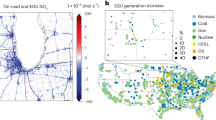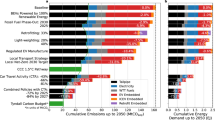Abstract
The use of plug-in electric vehicles in ride-hailing services is expected to have substantial emission reduction benefits. However, these benefits depend on the energy fuel mix in the grid and vehicle usage. Here we employ high-resolution data from Uber and Lyft in California to provide insights into the use of electric vehicles in ride-hailing. The growth in electric vehicle use has been rapid in the past two years and a proportionally small number of electric vehicles are already using a large share of electricity provided by the public charging infrastructure. Concerns about the ability of electric vehicles to provide the same level of service as gasoline vehicles has been overstated: we found no statistical difference between the two technologies for services provided to ride-hailing companies. Lastly, the potential environmental and emission reduction benefits are approximately three times higher for electric vehicles being used in ride-hailing compared with those of regular vehicle usage in California.
This is a preview of subscription content, access via your institution
Access options
Access Nature and 54 other Nature Portfolio journals
Get Nature+, our best-value online-access subscription
$29.99 / 30 days
cancel any time
Subscribe to this journal
Receive 12 digital issues and online access to articles
$119.00 per year
only $9.92 per issue
Buy this article
- Purchase on Springer Link
- Instant access to full article PDF
Prices may be subject to local taxes which are calculated during checkout







Similar content being viewed by others
Data availability
The data that support the findings of this study are available from EVGo, Chargepoint, Uber and Lyft, but restrictions apply to the availability of these data, which were used under license for the current study and so are not publicly available. The data from the CHTS are available from the Transportation Secure Data Center, National Renewable Energy Laboratory, at www.nrel.gov/tsdc. California grid load and emissions data are available from the California ISO Historical EMS Hourly Load Data (http://caiso.com/planning/pages/reliabilityrequirements/default.aspx#Historical) and Today’s Outlook (http://www.caiso.com/TodaysOutlook/Pages/emissions.aspx). Source data are provided with this paper.
Code availability
The code can be obtained by contacting the author directly at ajenn@ucdavis.edu.
References
Pavlenko, N., Slowik, P. & Lutsey, N. When Does Electrifying Shared Mobility Make Economic Sense? Working Paper 2019-01 (International Council on Clean Transportation, 2019).
Kley, F., Lerch, C. & Dallinger, D. New business models for electric cars—a holistic approach. Energy Policy 39, 3392–3403 (2011).
Luè, A., Colorni, A., Nocerino, R. & Paruscio, V. Green move: an innovative electric vehicle-sharing system. Procd Soc. Behav. Sci. 48, 2978–2987 (2012).
Becker, H., Ciari, F. & Axhausen, K. W. Measuring the car ownership impact of free-floating car-sharing—a case study in Basel, Switzerland. Transp. Res. D 65, 51–62 (2018).
Jacquillat, A. & Zoepf, S. Deployment and utilization of plug-in electric vehicles in round-trip carsharing systems. Int. J. Sustain. Transp. 12, 75–91 (2018).
Mounce, R. & Nelson, J. D. On the potential for one-way electric vehicle car-sharing in future mobility systems. Transp. Res. A 120, 17–30 (2019).
Xu, M., Meng, Q. & Liu, Z. Electric vehicle fleet size and trip pricing for one-way carsharing services considering vehicle relocation and personnel assignment. Transp. Res. B 111, 60–82 (2018).
Brendel, A. B., Lichtenberg, S., Brauer, B., Nastjuk, I. & Kolbe, L. M. Improving electric vehicle utilization in carsharing: a framework and simulation of an e-carsharing vehicle utilization management system. Transp. Res. D 64, 230–245 (2018).
Ai, N., Zheng, J. & Chen, X. Electric vehicle park-charge-ride programs: a planning framework and case study in Chicago. Transp. Res. D 59, 433–450 (2018).
Burghard, U. & Dütschke, E. Who wants shared mobility? Lessons from early adopters and mainstream drivers on electric carsharing in Germany. Transp. Res. D 71, 96–109 (2019).
Yang, Y., Zhang, W., Niu, L. & Jiang, J. Coordinated charging strategy for electric taxis in temporal and spatial scale. Energies 8, 1256–1272 (2015).
Rao, R., Cai, H. & Xu, M. Modeling electric taxis’ charging behavior using real-world data. Int. J. Sustain. Transp. 12, 452–460 (2018).
Tian, Z. et al. Understanding operational and charging patterns of electric vehicle taxis using GPS records. In 17th International IEEE Conference on Intelligent Transportation Systems 2472–2479 (IEEE, 2014).
Zou, Y., Wei, S., Sun, F., Hu, X. & Shiao, Y. Large-scale deployment of electric taxis in Beijing: a real-world analysis. Energy 100, 25–39 (2016).
Yang, J., Dong, J., Lin, Z. & Hu, L. Predicting market potential and environmental benefits of deploying electric taxis in Nanjing, China. Transp. Res. D 49, 68–81 (2016).
Teixeira, A. C. R. & Sodré, J. R. Simulation of the impacts on carbon dioxide emissions from replacement of a conventional Brazilian taxi fleet by electric vehicles. Energy 115, 1617–1622 (2016).
Clewlow, R. R. & Mishra, G. S. Disruptive Transportation: The Adoption, Utilization, and Impacts of Ride-hailing in the United States Research Report UCD-ITS-RR-17-07 (Institute of Transportation Studies, 2017).
Jenn, A., Laberteaux, K. & Clewlow, R. New mobility service users’ perceptions on electric vehicle adoption. Int. J. Sustain. Transp. 12, 526–540 (2018).
Cassetta, E., Marra, A., Pozzi, C. & Antonelli, P. Emerging technological trajectories and new mobility solutions. A largescale investigation on transport-related innovative start-ups and implications for policy. Transp. Res. A 106, 1–11 (2017).
Jittrapirom, P. et al. Mobility as a service: a critical review of definitions, assessments of schemes, and key challenges. Urban Plan. 2, 13–25 (2017).
Jalali, R., Koohi-Fayegh, S., El-Khatib, K., Hoornweg, D. & Li, H. Investigating the potential of ridesharing to reduce vehicle emissions. Urban Plann. 2, 26–40 (2017).
Sarasini, S. & Linder, M. Integrating a business model perspective into transition theory: the example of new mobility services. Environ. Innov. Societal Transit. 27, 16–31 (2018).
Barth, M. & Shaheen, S. A. Shared-use vehicle systems: framework for classifying carsharing, station cars, and combined approaches. Transp. Res. Rec. 1791, 105–112 (2002).
Sprei, F. Disrupting mobility. Energy Res. Soc. Sci. 37, 238–242 (2018).
Gessner, K. Uber vs. Lyft: Who’s Tops in the Battle of U.S. Rideshare Companies (Second Measures, accessed 1 January 2020); https://secondmeasure.com/datapoints/rideshare-industry-overview/
NuStats 2010–2012 California Household Travel Survey Final Report (California Department of Transportation, 2013).
Jenn, A., Lee, J. H., Hardman, S. & Tal, G. An in-depth examination of electric vehicle incentives: consumer heterogeneity and changing response over time. Transp. Res. A 132, 97–109 (2020).
Tal, G. & Nicholas, M. A. Studying the PEV market in California: comparing the PEV, PHEV and hybrid markets. In 2013 World Electric Vehicle Symposium and Exhibition 1–10 (IEEE, 2013).
Tal, G., Nicholas, M. A., Davies, J. & Woodjack, J. Charging behavior impacts on electric vehicle miles traveled: who is not plugging in? Transp. Res. Rec. 2454, 53–60 (2014).
Acknowledgements
This study was funded entirely by a grant from the National Center for Sustainable Transportation (NCST), supported by USDOT through the University Transportation Centers programme. The authors thank the NCST and USDOT for their support of university-based research in transportation, and especially for the funding provided in support of this project.
Author information
Authors and Affiliations
Contributions
A.J. conducted all the analysis and manuscript writing and editing.
Corresponding author
Ethics declarations
Competing interests
The author declares no competing interests.
Additional information
Publisher’s note Springer Nature remains neutral with regard to jurisdictional claims in published maps and institutional affiliations.
Supplementary information
Source data
Source Data Fig. 1
Data for Fig. 1: contains the distribution of daily miles travelled across different types of vehicles and services. Each row corresponds to one day of travel in the sample of data. (Sources: California Household Travel Survey, EVGo and Chargepoint charging data, PH&EV survey data, and Lyft trip data).
Source Data Fig. 2
Data for Fig. 2: contains daily trip miles of electric vehicles and gas vehicles from TNCs in 2017–2018 (Source: Lyft trip data).
Source Data Fig. 3
Data for Fig. 3: weekly total charging demand from public and DC fast chargers for TNC vehicles from 2016 to 2018 (Source: PH&EV survey data, and EVGo and Chargepoint charging data).
Source Data Fig. 4
Data for Fig. 4: daily charging demand [kWh] from public charging network providers for both ordinary electric vehicles and from TNC electric vehicles (Source: PH&EV survey data, and EVGo and Chargepoint charging data).
Source Data Fig. 5
Data for Fig. 5: count of number of daily charging events broken down by the deciminute of the day and city in California (Source: PH&EV survey data, and EVGo and Chargepoint charging data).
Source Data Fig. 6
Data for Fig. 6: upstream electricity grid emissions corresponding to each mileage event (Source: PH&EV survey data, EVGo and Chargepoint charging data, CA-ISO daily load and emissions data).
Source Data Fig. 7
Data for Fig. 7: calculated emissions savings from switching to an electric vehicle for ordinary drivers and for TNC drivers (Source: PH&EV survey data, EVGo and Chargepoint charging data, California Household Travel Survey).
Rights and permissions
About this article
Cite this article
Jenn, A. Emissions benefits of electric vehicles in Uber and Lyft ride-hailing services. Nat Energy 5, 520–525 (2020). https://doi.org/10.1038/s41560-020-0632-7
Received:
Accepted:
Published:
Issue Date:
DOI: https://doi.org/10.1038/s41560-020-0632-7
This article is cited by
-
Economic and environmental benefits of automated electric vehicle ride-hailing services in New York City
Scientific Reports (2024)
-
Impact of battery electric vehicle usage on air quality in three Chinese first-tier cities
Scientific Reports (2024)
-
The Sequential Pricing of Ride-Hailing System with Rental Service in the Context of Fleet Electrification
Journal of Systems Science and Systems Engineering (2024)
-
Silver Nanofluid-Based Thermal Management for Effective Cooling of Batteries in Electric Vehicle Systems
Arabian Journal for Science and Engineering (2024)
-
Decarbonization potential of electrifying 50% of U.S. light-duty vehicle sales by 2030
Nature Communications (2023)



